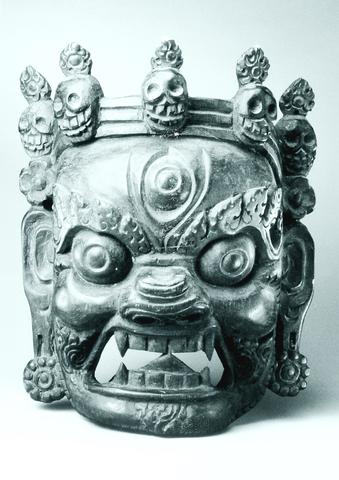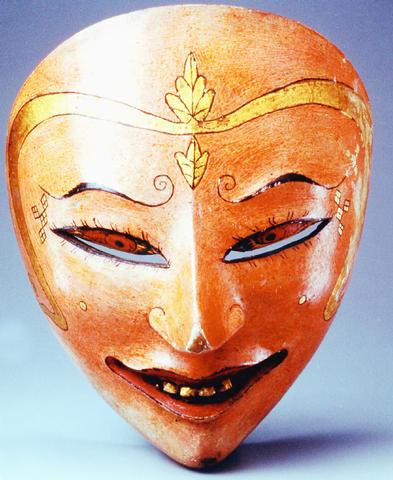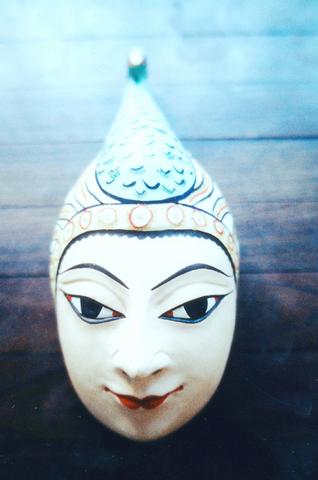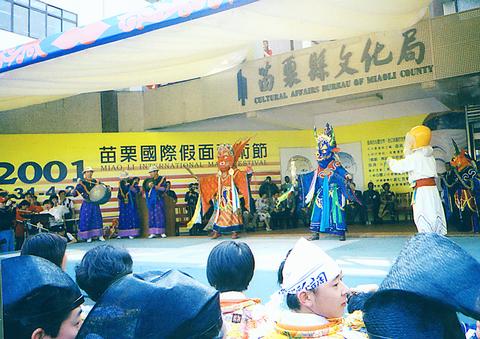The Second Miaoli International Mask Festival (第二屆苗栗國際假面藝術節), which opened Saturday, is presenting one of the most comprehensive exhibitions of Asian masks ever held in Taiwan. The event, which runs until April 29, will also incorporate an array of folk music and dance performances associated with the use of masks.
The exhibition and performances are sponsored by the Miaoli County Culture Bureau (

PHOTO COURTESY OF ACEF
The current exhibition, which focuses on Asia, contains 403 masks, many of them over a century old. Highlights of the exhibition are two sacrificial masks from Java which date back 1,000 years, one of which is made of gold, the other of bronze. Securing these objects' shipment to Taiwan for the show was perhaps the event's biggest coup. "Insurance made up a large part of the expenses for this show," said Chou.

PHOTO COURTESY OF ACEF
The mask exhibition takes the form of an installation art display and aims to cover the two main traditions of mask art in Asia, Chinese and Indian. Chou said said viewers will be able to see the frequent overlap of the traditions,especially visible in the mask art of regions like Tibet. Featured masks originate from Mongolia, Tibet, China, Japan, Taiwan, Thailand, India, Nepal and Sri Lanka.
The Miaoli Mask Festival was initiated in 1999 during the preparation for the construction of the Sanyi Museum of Wood Sculpture (三義木雕博物館), when cultural administrators happened upon the strong vein of mask art that exists within Miaoli's wood carving tradition.

PHOTO COURTESY OF ACEF
The subtitle of the show "Masks, a Banquet for the Soul" (假面的藝術,心靈的饗宴) is intended to emphasize the important role that masks play in expressing religious aspirations and the importance of masks in traditional culture.

PHOTO COURTESY OF ACEF
Although masks are not commonly used in Chinese ritual or performance, Hakka (客家) culture, which is strongly represented in Miaoli, uses masks in funeral rites, which explains the choice of Miaoli for the event.
Hakka masks will be on display, as will another form of Chinese masks, called "Nuo" (儺面), which date back to the Tang dynasty (618-907) and are currently only used in China's relatively isolated Guizhou (貴州) and Jiangxi (

PHOTO: TIFFANY FENG, TAIPEI TIMES
One of the most dynamic elements of the festival will be performances by troupes from all over the world. These will be held in many different locations around Miaoli and most, with the exception of those by higher-profile dance groups, will be free.
Organizers say the event is a rare opportunity to learn about the rich heritage and multiple religious and cultural usages of masks. "By wearing a mask I represent a ghost. In the northeast of Thailand, the masked performers scare away evil spirits that lurk in the wilderness," said one ghost performer of the Nongkhai Dramatic Art Club (農凱戲劇藝術團) from Thailand.
Members of Mongol National Ethnic Dance Group (蒙古國家民族歌舞團) said that their masks were representations of Buddha, and their performance was intended to subdue demons and enhance people's faith in Buddhism.
Fu Hsueh-peng (傅學鵬), Miaoli County commissioner, said he hoped the arts festival would become a regular event to show off Miaoli's culture and give Miaoli residents a chance to learn more about the cultures of other nations.
What: The Second Miaoli International Mask Festival (
When: April 1 to April 29, 9am to 9pm
Where: Miaoli County Culture Bureau (
Ticket: Exhibition NT$100; Performances, free or NT$100 to NT$500
For more information call (037) 352-961 ext. 611-614 or check out the festival Web site at http://www.mask.org.tw.

Many people noticed the flood of pro-China propaganda across a number of venues in recent weeks that looks like a coordinated assault on US Taiwan policy. It does look like an effort intended to influence the US before the meeting between US President Donald Trump and Chinese dictator Xi Jinping (習近平) over the weekend. Jennifer Kavanagh’s piece in the New York Times in September appears to be the opening strike of the current campaign. She followed up last week in the Lowy Interpreter, blaming the US for causing the PRC to escalate in the Philippines and Taiwan, saying that as

Nov. 3 to Nov. 9 In 1925, 18-year-old Huang Chin-chuan (黃金川) penned the following words: “When will the day of women’s equal rights arrive, so that my talents won’t drift away in the eastern stream?” These were the closing lines to her poem “Female Student” (女學生), which expressed her unwillingness to be confined to traditional female roles and her desire to study and explore the world. Born to a wealthy family on Nov. 5, 1907, Huang was able to study in Japan — a rare privilege for women in her time — and even made a name for herself in the

Would you eat lab-grown chocolate? I requested a sample from California Cultured, a Sacramento-based company. Its chocolate, not yet commercially available, is made with techniques that have previously been used to synthesize other bioactive products like certain plant-derived pharmaceuticals for commercial sale. A few days later, it arrives. The morsel, barely bigger than a coffee bean, is supposed to be the flavor equivalent of a 70 percent to 80 percent dark chocolate. I tear open its sealed packet and a chocolatey aroma escapes — so far, so good. I pop it in my mouth. Slightly waxy and distinctly bitter, it boasts those bright,

“Taiwanese increasingly reluctant to give their lives to defend the island,” trumpeted a South China Morning Post (SCMP) headline last week. The survey asked whether people should be prepared to pay any price — including death — to protect Taiwan and prevent “reunification.” “The poll found that 52.2 percent of those questioned were unwilling to do so — an 8.4-point rise compared with a similar survey carried out two years ago — while 40.8 percent were willing, down four points on the previous survey,” the article said. Treated as anti-Taiwan propaganda, the piece was sent around by the usual pro-China suspects